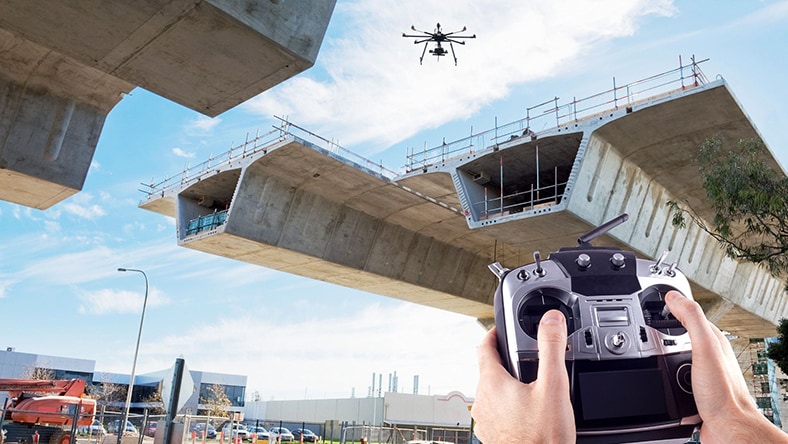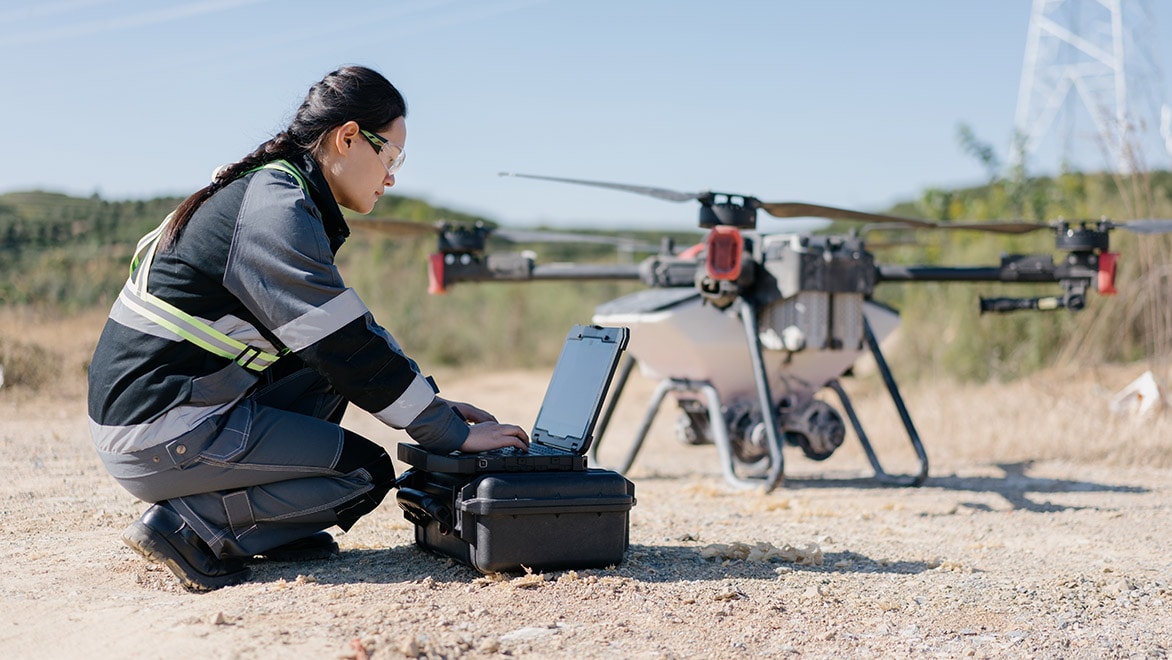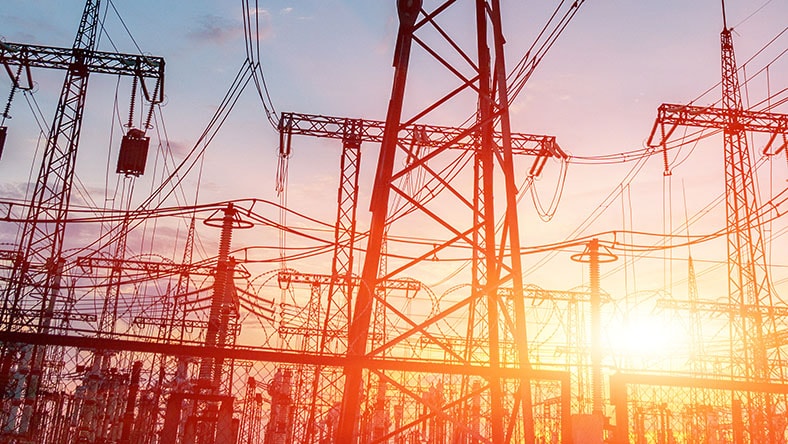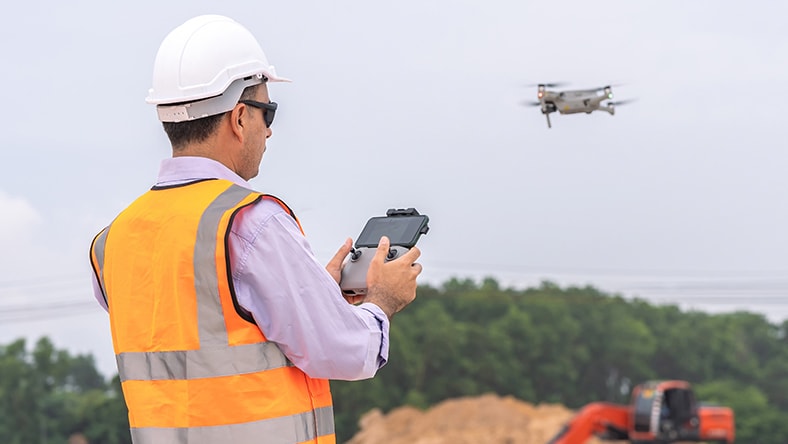& Construction

Integrated BIM tools, including Revit, AutoCAD, and Civil 3D
& Manufacturing

Professional CAD/CAM tools built on Inventor and AutoCAD
Drone surveying is a technique that employs unmanned aerial vehicles (drones) equipped with sensors, cameras, and GPS to gather data and create precise maps, models, and 3D earth representations.
Drone surveying can benefit many industries by efficiently gathering precise aerial data.
Drone surveying can capture existing conditions for renovation in a safe, efficient manner.
Drones can monitor crops, estimate yields, detect diseases, and optimize irrigation.
Drones monitor wildlife habitats, track ecosystem changes, and assess the environment.
Drones provide a safe method for inspecting critical infrastructure such as bridges and pipelines.
Here's how the drone data collection process works:
Flight planning: Before a drone takes off, surveyors plan its flight path over the area of interest. This path is often defined using GPS waypoints, ensuring that the drone systematically covers the entire area.
Data collection: Surveying drones are equipped with various types of sensors, such as RGB cameras, multispectral cameras, and LiDAR (Light Detection and Ranging). These sensors capture images, videos, or even laser pulses that bounce off the ground, structures, and vegetation.
Image capture: Cameras on a drone capture high-resolution images from various angles as it flies over a designated area. These images overlap to ensure comprehensive coverage and accurate mapping.
Data processing: After a surveying drone has collected data, it is transferred to a computer for processing. Software is used to stitch the individual images together, creating a cohesive mosaic that represents the entire area. In the case of LiDAR data, information is processed to create detailed elevation models.
Mapping and analysis: Once data is processed, it can be used to create various outputs, such as orthomosaic maps (geo-referenced images with corrected perspective), digital elevation models (DEM), 3D models, contour lines, and vegetation health maps (using multispectral data).
Drones can cover large areas in a short time, reducing the need for manual labor, equipment, and time-intensive processes, resulting in significant cost savings.
Equipped with advanced GPS and sensor technology, drones can provide highly accurate and detailed data, leading to precise maps, models, and measurements.
Drones eliminate the need for surveyors to physically access hazardous or difficult-to-reach areas, improving worker safety and minimizing risk.
Drones can carry various types of cameras, with sensors collecting various types of data adapted for different applications.
Drones can access locations that are challenging for humans to reach, such as elevated structures or inaccessible and dangerous terrain.
Powerful BIM and CAD tools for designers, engineers, and contractors, including Revit, AutoCAD, Civil 3D, Autodesk Forma, and more
CONSORCIO IUYET
Civil engineering services firm uses drone surveying and the Autodesk AEC collection to build a safe train on difficult terrain.
ATFF
French reality capture firm deploys drones to survey Europe’s most challenging locations.
WASKITA KARYA
State-owned construction firm transitions from 2D to 5D with drone surveying, Civil 3D, and Revit.
See how modern tools help a small island community promote sustainable development while keeping traditional customs alive.
Explore a new wave of digital preservation guarding valuable history from accidents, climate change, and deterioration.
See how France preserves precious landmarks and prepares for future restorations with 3D technology.
Surveying drones equipped with sensors such as RGB cameras, multispectral cameras, thermal cameras, and LiDAR sensors collect data by flying over designated areas according to predetermined flight paths. These sensors capture images, thermal data, or laser pulses that bounce off surfaces. The drones are equipped with GPS technology for precise positioning and georeferencing. Data is collected through multiple images taken from different angles, ensuring overlap for accurate mapping. After the flight, collected data is processed using specialized software to create orthomosaic maps, 3D models, and elevation maps.
The accuracy of a drone survey varies based on factors like the drone's type, sensor quality, flight planning, and post-processing methods. Drone surveys can achieve horizontal accuracies ranging from centimeters to decimeters and similar vertical accuracies, depending on factors such as GPS technology and ground control points. Different sensor types like RGB cameras, multispectral cameras, and LiDAR offer varying levels of accuracy, with LiDAR often providing sub-centimeter accuracy. Factors including ground control points, post-processing quality, surveying methodology, environmental conditions, and equipment quality influence accuracy.
Drone surveying holds distinct advantages over traditional methods. It excels in efficiency, swiftly covering expansive areas and significantly reducing costs and project timelines. The accuracy, facilitated by advanced sensors and GPS, rivals or surpasses traditional methods. Safety is heightened when drones can access hazardous or remote areas remotely, while real-time monitoring aids quick decision-making. The versatility of drones, accommodating various sensors and applications, bolsters their appeal. With minimized environmental disruption, data visualization clarity, and seamless integration, drones are innovative tools that offer flexibility in challenging terrains, quick deployment, and comprehensive project documentation, making them a transformative technology across diverse industries.
Drone surveys have diverse applications across industries. They can monitor construction progress, assess crop health, estimate yields in agriculture, calculate stockpile volumes in mining, track environmental changes, inspect infrastructure, aid emergency response efforts, manage forests, preserve cultural heritage, facilitate property assessments, assist urban planning, enhance energy sector operations, support disaster management, expedite insurance claims, capture cinematic shots, aid wildlife conservation, optimize golf course maintenance, monitor coastal and marine environments, and enable precision agriculture. These versatile tools enhance efficiency, accuracy, and safety in numerous sectors, transforming how data is collected, analyzed, and applied.








